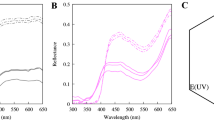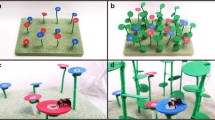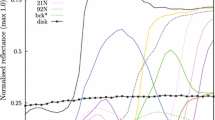Abstract
We wished to understand the effects on pollinator behaviour of single mutations in plant genes controlling flower appearance. To this end, we analysed snapdragon flowers (Antirrhinum majus), including the mixta and nivea mutants, in controlled laboratory conditions using psychophysical tests with bumblebees. The MIXTA locus controls petal epidermal cell shape, and thus the path that incident light takes within the pigment-containing cells. The effect is that mixta mutant flowers are pink in comparison to the wild type purple flowers, and mutants lack the sparkling sheen of wild type flowers that is clearly visible to human observers. Despite their fundamentally different appearance to humans, and even though bees could discriminate the flowers, inexperienced bees exhibited no preference for either type, and the flowers did not differ in their detectability in a Y-maze—either when the flowers appeared in front of a homogeneous or a dappled background. Equally counterintuitive effects were found for the non-pigmented, UV reflecting nivea mutant: even though the overall reflectance intensity and UV signal of nivea flowers is several times that of wild type flowers, their detectability was significantly reduced relative to wild type flowers. In addition, naïve foragers preferred wild type flowers over nivea mutants, even though these generated a stronger signal in all receptor types. Our results show that single mutations affecting flower signal can have profound effects on pollinator behaviour—but not in ways predictable by crude assessments via human perception, nor simple quantification of UV signals. However, current models of bee visual perception predict the observed effects very well.





Similar content being viewed by others
References
Backhaus W, Menzel R, Kreissl S (1987) Multidimensional scaling of color similarity in bees. Biol Cybern 56:293–304
Bradshaw HD, Schemske DW (2003) Allele substitution at a flower color locus produces a pollinator shift in two monkeyflower species (Mimulus). Nature 426:176–178
Chittka L (1992) The color hexagon: a chromaticity diagram based on photoreceptor excitations as a generalized representation of colour opponency. J Comp Physiol A 170:533–543
Chittka L, Waser NM (1997) Why red flowers are not invisible for bees. Isr J Plant Sci 45:169–183
Chittka L, Tautz J (2003) The spectral input to honeybee visual odometry. J Exp Biol 206:2393–2397
Chittka L, Shmida A, Troje N, Menzel R (1994) Ultraviolet as a component of flower reflections, and the colour perception of hymenoptera. Vision Res 34:1489–1508
Chittka L, Dyer AG, Bock F, Dornhaus A (2003) Bees trade off foraging speed for accuracy. Nature 424:388–388
Chittka L, Ings TC, Raine NE (2004) Chance and adaptation in the evolution of island bumblebee behaviour. Popul Ecol 46:243–251
Comba L, Corbet SA, Hunt H, Outram S, Parker JS, Glover BJ (2000) The role of genes influencing the corolla in pollination of Antirrhinum majus. Plant Cell Environ 23:639–647
Dyer AG, Chittka L (2004a) Biological significance of discriminating between similar colours in spectrally variable illumination: bumblebees as a study case. J Comp Physiol A 190:105–114
Dyer AG, Chittka L (2004b) Bumblebees (Bombus terrestris) sacrifice foraging speed to solve difficult colour discrimination tasks. J Comp Physiol A 190:759–763
Dyer AG, Chittka L (2004c) Fine colour discrimination requires differential conditioning in bumblebees. Naturwissenschaften 91:224–227
Dyer AG, Whitney HM, Arnold SEJ, Glover BJ, Chittka L (2006) Bees associate warmth with floral colour. Nature 442:525–525
Giurfa M (2004) Conditioning procedure and color discrimination in the honeybee Apis mellifera. Naturwissenschaften 91:228–231
Giurfa M, Núñez J, Chittka L, Menzel R (1995) Colour preferences of flower-naive honeybees. J Comp Physiol A 177:247–259
Giurfa M, Vorobyev M, Kevan P, Menzel R (1996) Detection of coloured stimuli by honeybees: minimum visual angles and receptor specific contrasts. J Comp Physiol A 178:699–709
Glover BJ, Martin C (1998) The role of petal cell shape and pigmentation in pollination success in Antirrhinum majus. Heredity 80:778–784
Glover BJ, Perez-Rodriguez M, Martin C (1998) Development of several epidermal cell types can be specified by the same MYB-related plant transcription factor. Development 125:3497–3508
Gorton HL, Vogelmann TC (1996) Effects of epidermal cell shape and pigmentation on optical properties of Antirrhinum petals at visible and ultraviolet wavelengths. Plant Physiol 112:879–888
Hodges SA, Fulton M, Yang JY, Whittall JB (2003) Verne Grant and evolutionary studies of Aquilegia. New Phytol 161:113–120
Kay QON, Daoud HS, Stirton CH (1981) Pigment distribution, light reflection and cell structure in petals. Bot J Linn Soc 83: 57–84
Kevan PG, Lane MA (1985) Flower petal microtexture is a tactile cue for bees. Proc Natl Acad Sci 82:4750–4752
Kevan P, Giurfa M, Chittka L (1996) Why are there so many and so few white flowers? Trends Plant Sci 1:280–284
Kevan PG, Chittka L, Dyer AG (2001) Limits to the salience of ultraviolet: lessons from colour vision in bees and birds. J Exp Biol 204:2571–2580
Lehrer M, Srinivasan MV, Zhang SW (1990) Visual edge detection in the honeybee and its chromatic properties. Proc R Soc Lond B 238:321–330
Lunau K, Maier EJ (1995) Innate colour preferences of flower visitors. J Comp Physiol A 177:1–19
Lunau K, Wacht S, Chittka L (1996) Colour choices of naive bumble bees and their implications for colour perception. J Comp Physiol A 178:477–489
Luo D, Carpenter R, Vincent C, Copsey L, Coen E (1996) Origin of floral asymmetry in Antirrhinum. Nature 383:794–799
Neumeyer C (1980) Simultaneous color contrast in the honey bee. J Comp Physiol 139:165–176
Noda K, Glover BJ, Linstead P, Martin C (1994) Flower colour intensity depends on specialised cell shape controll ed by a MYB-related transcription factor. Nature 369:661–664
Peitsch D, Fietz A, Hertel H, de Souza J, Ventura DF, Menzel R (1992) The spectral input systems of hymenopteran insects and their receptor-based colour vision. J Comp Physiol A 170:23–40
Rival C, Oliver I, Ceyte H (2003) Effects of temporal and/or spatial instructions on the speed-accuracy trade-off of pointing movements in children. Neurosci Lett 336:65–69
Spaethe J, Chittka L (2003) Interindividual variation of eye optics and single object resolution in bumblebees. J Exp Biol 206:3447–3453
Spaethe J, Tautz J, Chittka L (2001) Visual constraints in foraging bumblebees: Flower size and color affect search time and flight behavior. Proc Natl Acad Sci (USA) 98:3898–3903
Srinivasan MV, Lehrer M (1988) Spatial acuity of honeybee vision and its spectral properties. J Comp Physiol A 162:159–172
Srinivasan MV, Zhang S, Altwein M, Tautz J (2000) Honeybee navigation: nature and calibration of the “odometer”. Science 287:851–853
Vorobyev M, Gumbert A, Kunze J, Giurfa M, Menzel R (1997) Flowers through insect eyes. Isr J Plant Sci 45:93–101
Waser N, Chittka L (1998) Bedazzled by flowers. Nature 394:835–836
Whibley AC, Langlade NB, Andalo C, Hanna AI, Bangham A, Thebaud C, Coen E (2006) Evolutionary paths underlying flower color variation in Antirrhinum. Science 313:963–966
Wienand U, Sommer H, Schwarz-Sommer Z, Shepherd N, Saedler H, Kreuzaler F et al (1982) A general method to identify plant structural genes among genomic DNA clones using transposable element induced mutations. Mol Gen Genet 187:195–201
Zhang SW, Srinivasan MV (1994) Prior experience enhances pattern discrimination in insect vision. Nature 368:330–332
Acknowledgements
The authors would like to thank Matthew Dorling for care of plants and Martin Girfa for discussion. This work was funded by the Nature and Environment Research Council (NERC NE/C000552/1 to BJG and LC).
Author information
Authors and Affiliations
Corresponding author
Additional information
Handling Editor: Heikki Hokkanen.
Rights and permissions
About this article
Cite this article
Dyer, A.G., Whitney, H.M., Arnold, S.E.J. et al. Mutations perturbing petal cell shape and anthocyanin synthesis influence bumblebee perception of Antirrhinum majus flower colour. Arthropod-Plant Interactions 1, 45–55 (2007). https://doi.org/10.1007/s11829-007-9002-7
Received:
Accepted:
Published:
Issue Date:
DOI: https://doi.org/10.1007/s11829-007-9002-7




